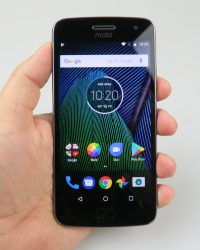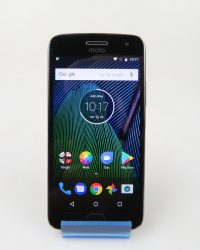You may have noticed we’ve played with a flood of Motorola phones over the past year, basically 8 or 10 of them, so we’re super familiar with this brand. One of the devices we’ve tested is the Motorola Moto G5 Plus, which came after the Moto G5. We’ve reviewed it and all the details you need are below. Launched this Spring, this device is priced at $229.

It gravitates in the same range as the ASUS ZenFone 3 and Huawei Nova, with similar specs. Available in gray or gold, this is one of the cheapest devices that can film 4K. The design is very similar to the Moto G5, only bigger. It’s a bit of Motorola trademark, in the camera and fingerprint/Home button area (rounded and oval respectively). The device is covered with a water repellant coating.
While the Moto G4 had a plastic case, the G5 is all about metal. It comes with a solid build, good grip and easy one hand use. The buttons are comfy and we’ve got a plastic top and bottom portion. Motorola Moto G5 Plus measures 7.7 mm in thickness, going all the way to 9.7 mm if you consider the camera bump. Moto G5 Plus weighs 155 grams, which is OK for a 5.2 incher. Interestingly this diagonal is a drop from the 5.5 inches of the Moto G4 Plus.
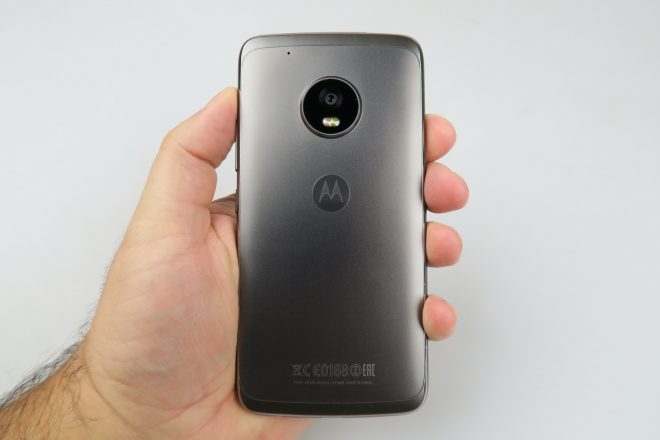
The thickness has decreased compared to that model and the weight is the same. What’s certain is that this device has personaly and you can tell it’s a Moto from a mile away. It’s also a bit too wide for its own good, but not in an exaggerate fashion. Let’s talk about the display now! We’ve got a 5.2 incher here with a Full HD resolution and 424 ppi density.
There’s Gorilla Glass 3 protection and the IPS LCD panel is put to work here. The viewing experience was as follows: bright, crisp, wide angles all the way and well calibrated colors. Colors are a bit on the cold side and I felt that the image is too white. Pixels have an RGB Stripes arrangement and the luxmeter shows a value of 400 LUX, which is just at the limit of being good.

This beats the LeEco Le Max 2 and Huawei Nova, but scores below the Nokia 3 and Huawei P9 Lite. Settings let you tweak the brightness level, there’s also adaptive brightness . Color Mode offers options like Standard or Vibrant. There’s font size too, display size and overall it’s an OK display.
Moving on to the hardware front, there’s a Qualcomm Snapdragon 625 CPU here, an octa core one clocked at 2 GHz, with an Adreno 506 GPU in the mix. The handset has quite a few RAM versions: 2 GB, 3 GB or 4 GB. Storage comes in 32 or 64 GB flavours and there’s also microSD here. We didn’t experience lag, we ran multiple apps and while this is not flagship snappy, but close enough.

Riptide GP Renegade runs OK, in frame rate, fluidity, shadows, textures and everything. As far as benchmarks go, we did Quadrant, in which we beat the Huawei Mate 9 and Huawei P9 Lite, but we scored below the Vernee Thor and Huawei P10 Lite. In AnTuTu 6 we scored above the Huawei Nova and Huawei P10 Lite, but also below the Huawei P9 and Lenovo Vibe X3.
In GeekBench 4 we did the single core test and surpassed the ZenFone 3, while also not being able to beat the Xperia XA1. Multi core tests revealed a result superior to the LG G6, but below the Honor 8. Overall, Moto G5 Plus beats the ZenFone 3 and Huawei Nova and even goes above the Moto G5 by about 30%. For a Plus model that’s a lot. On the temperature front there was zero overheating: 32.3 degrees Celsius in GFXBench and 34.8 degrees in Riptide GP Renegade.

Time to discuss the battery. It’s a 3000 unit, that on paper promises all day battery life. Moto also bundled Turbo Power, which is supposed to offer 6 hours of usage after 15 minutes of juice up. As far as the video playback time goes, we achieved 11 hours and 39 minutes of video playback, which is quite good, getting close to the famous landmark of 12 episode Netflix season.

With this achievement the device goes past iPhone 6 and Galaxy S6 Edge Plus, but it scores below the Xiaomi Mi 5 and Huawei P10 Plus. Sadly PCMark wouldn’t work, which also happened on the Moto G5. With regular usage, we caught one whole day of use, or even a whole day and some extra 5-6 hours. Charging requires 1 hour and 30 minutes, which is great, much better than the usual midranger phones.
It’s also superior to the HTC 10 and Galaxy S8 and we did charging in stages, with 5 minutes leading us to 11% and 15 minutes to 26%. After 30 minutes of charging we reached 49%. Settings includes Battery Optimization and Battery Saver, stock stuff. Time to see if the acoustics are just as good or not. The earpiece is quite bit, which is no coincidence, since the earpiece is also used to listen to music.
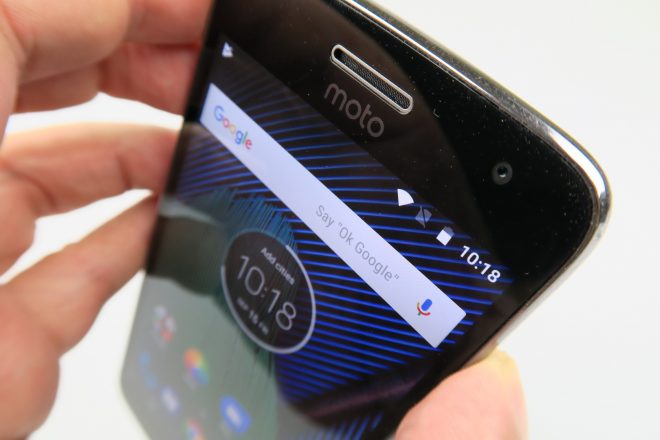
Google Play Music is the music player of choice, with a 5 channel EQ included and surround, plus Bass Punch and Vocalizer. When the music starts, we find the sound is very crisp, loud, clear, the bass is solid and there’s no vibration of the case or distortion. It’s all great to me. There are no bundled headphones, but we do have FM Radio. We also did a decibelmeter test and achieved 88.6 dBA at the front and top, while at the back the result is 85.2 dBA. These results place the Moto G5 Plus above the Huawei P10 and Bluboo S1, but below the Galaxy Note 4 and OnePlus One.
In Riptide GP Renegade we achieved 95.1 dBA, which is excellent, but no record breaker. It’s certainly higher than the Nubia N1 and Moto G5, but inferior to the Xperia L1 and Bluboo S8. Settings let you Power Up Sound some more. Great acoustics overall, but maybe go stereo next time Moto! Time to talk about the camera. Motorola Moto G5 Plus packs a 12 megapixel main camera, with dual autofocus pixels, 4K video capture and F/1.7 aperture.

There’s a dual LED flash here and upfront we’ve got a 5 MP camera with wide angle lens and F/2.2 aperture. There’s also Display Flash, like on the iPhones. The camera UI is all Android stock and the camera app starts up slow, but the focus speed is not bad. The picture taking speed is OK. Options include Timer, HDR, Panorama, Slow Motion and when Manual is activated, there’s exposure, white balance, focus, shutter and ISO to tweak.

Let’s move on to the day time gallery and first of all we’ve got a HDR that makes things look more realistic and less artificial. It does make things extra bright, but that’s OK. Pics lack the gloss of the flagship level cameras, selfies are OK, in color, texture and even the background. We’ve got some blur and ghosting here and there, but if you’re patient enough, you can focus properly. Closeups are solid, with good details and the colors are well calibrated.

In the shade we can see some blur here and there. The Panorama is kinda small, at 2856 x 936 pixels, I have to say. If you’re looking for an ideal shot done with this phone, it has got to be the one of the pink rose. Get proper light, be patient to focus and results will come. Treat this like an iPhone that takes shots even when running (slight exaggeration) and blur will abund.

In the end the photo taking during the day feels a bit average, in the area of the ZTE Nubias and Allviews, or maybe Huawei Honor models. It’s below the Xperia XA1 and Huawei P10 Lite for sure. Details aren’t half bad and I feel that the jump from the Moto G4 is at least by 10%, so that’s OK. The G4 caught more artificial colors, which are gone now. Selfies are actually quite decent, or more than that, having seen higher profile and more famous phones calibrating light worse than this model does with its front cam.

When it comes to low light pic capture, I found the flash to be OK, but we did achieve some blur, sadly. Zoom is poor, dropping a lot of details and there’s a persistent blue hue that annoys me. We get grain, big halos, lots of yellow and some moved shots. Pics are brighter and clearer than on the Moto G4 once again, but they can’t compare with the Huawei P9 Lite (2017) and P10 Lite.
Its biggest problem is the lack of constance. Not very impressive, to be honest. As far as video capture goes, we shot things in MP4 format, Full HD, at 30 or 60 FPS. As we said, there’s also 4K video capture here somehow. There’s a good microphone in action here, with a crisp rendition of the ambiance and voices. Even with the win the mic remains solid. There was some burn in the video capture, clarity was OK and colors too.
The 4K video is crisp, but not iPhone or Galaxy S8 crisp, rather Galaxy S5 level, when it was rather experimental. The bitrate is at 50 Mbps, which is great. I found the videos to be quite impressive, especially compared to the pics. They’re glossy, and have good dynamic range, plus the zoom is not bad. There’s no refocusing and I think it can fight the Huawei P10 Lite. ASUS ZenFone 3 and Xperia XA1, so that’s nice for 200 bucks.
Colors are great and the 60 FPS is cinematic and well rendered. Not bad, surprisingly not bad at all. When it comes to low light filming, we dropped to 23 or 24 FPS, plus we had big street light halos. The image was shaky, but object tracking was quite OK. Brightness was well within good limits, but things got shaky when walking around. I have to highlight the halos again, because in later captures they got downright huge.
Zoom was poor, dropping details and overall I found the brightness and colors to be OK. I would say that the capture is OK for the price, in spite of the drawbacks. Good microphone, too. I’d call the video capture a surprise overall, while the pics are so-so. When it comes to browsing, we obviously used Chrome, which has a pretty OK speed, but also poor benchmarks (we did Sunspider and Vellamo). The keyboard is of the stock variety, it has Swype and it was quite comfy to use.
Let’s talk about connectivity now! The Moto G5 Plus uses a microUSB 2.0 port, also has an audio jack and 2 microphones. There’s a nano SIM slot here, Bluetooth 4.2, WiFi a/b/g/n support, GPS, Glonass and support for 4G LTE Category 6. This handset is available in single SIM or dual SIM versions and also comes with FM Radio. Calls were very loud and clear, something I always expect from the inventor of mobile phones, Motorola.

We also did a SpeedTest and achieved 113 Mbps in download on WiFi and 25 Mbps in upload. On 4G results sit at 65 Mbps in download and 45 Mbps in upload. Time to check out the OS, UI and apps. We’re running on Android 7.0 Nougat here, with a stock interface and things are pretty basic and straight forward. The leftmost homescreen is meant for Google Now and its results, news, reminders and such.
Multitasking happens via a carousel once you press the Recents button, plus the split screen thingie is also available. The dropdown bit shows notifications and quick settings, as usual. Keep the homescreen pressed and you’ll trigger the wallpapers, widgets (stock) and rotation of the homescreen. Settings are stock, give or take the Motorola Privacy thing.
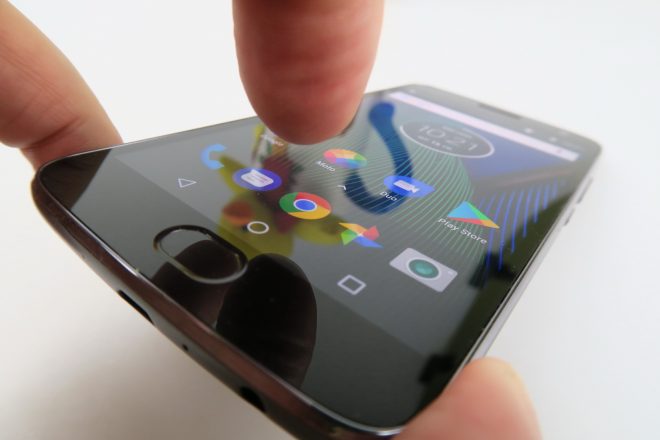
The fingerprint scanner upfront has a 12 step setup process and it’s fast and accurate when it comes to the actual unlocking. It was pretty snappy for a midranger. We checked out the apps list, the preinstalled one and found 26 names. This is great, since there’s no bloatware or useless apps, just standard Google ones. Among those Moto Actions stands out with its Gestures (twist, chop and more to trigger various functions).

There’s also Glance, that shows notifications, time and date if you move the phone on the standby screen. One fact I must also mention is that I’m digging the wallpapers on this phone quite a lot. So, here we are, at the end of the review, so it’s time for the verdict.
Here are the Pros:
- design has personality
- stock UI
- no bloatware
- OK performance
- good screen
- good video playback time (battery life)
- fast charging
- loud audio
- good video capture
- solid connectivity
And the Cons:
- PCMark won’t run
- a bit thick
- some blurred shots
- unimpressive low light pictures
- realistic price is $30 or $50 less
Motorola Moto G5 Plus is a solid rival for the Huawei P9 Lite (2017), as well as the Huawei P10 Lite. It doesn’t have a major deal breaker and it stands out through the video capture that the camera does, a quality one and also the solid performance for a midranger. Battery life is OK, as far as the video playback goes and this is the kind of handset, that has a little bit of everything.
It has a stock OS and UI and it’s clear jump in performance from the Moto G4 and Moto G5. It was surprising to find it 30% superior in benchmarks, so if you really want a G5, get the G5 Plus over the regular model. Here’s the latest price for the device.























